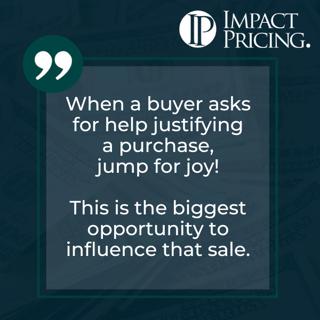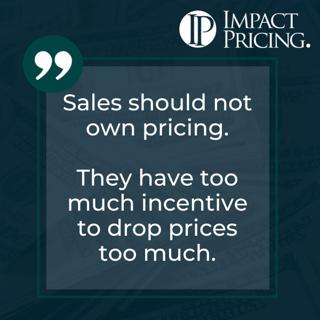
Memecast #49: Sales Should Not Own Pricing
Salespeople love them to death, however, it's more important to them to close the deal than to close it at the highest possible price. In fact, if they stay and negotiate a little bit harder, they're at risk of losing the deal. And if they lose the deal, they lose their commission. They lose the ability to reach their quotas. So, for them, their incentives are a little bit askew from what our incentives should be. And when I say our, let's say the company, the owners of the company, or us as pricing people, where we want to try to win deals at the highest possible price. So, although salespeople are really selling value and they're doing their best, in the end, price is just one of the many tools they have to try to close a deal and they're going to use every tool they have. So, I don't think salespeople should own pricing. Sure, we should give them a little bit of flexibility, a little bit of price authority to help them move deals along quicker, but to give them complete authority, probably a big mistake. We hope you enjoyed this memecast. If you have any questions or feedback, please email me mark@impactpricing.com. Now, go make an impact. Connect with Mark Stiving: Email: mark@impactpricing.com LinkedIn: https://www.linkedin.com/in/stiving/
16 Mars 20221min
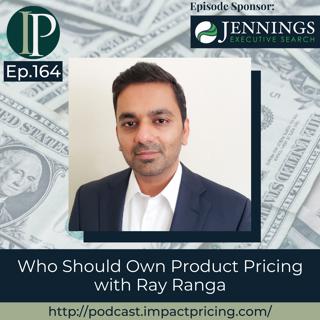
Who Should Own Product Pricing with Ray Ranga
Ray Ranga is currently the VP of Product Management at Momentive AI. Before working in Momentive, Ray was the Senior Director of Product Management at Splunk. Ray is an instructor at UC Berkeley and he also conducts a pricing class at Stanford. In this episode, Ray discusses the power behind involving the people who know the product’s value when making pricing decisions as he specifically points out the benefits of having pricing teams connect with people from the product management department. Why you have to check out today’s podcast: Discover which team should own pricing in a company in relation to the value the product has; Find out how to effectively package products in a way that resonates best with what your customers want; and Understand why pricing and product management people should be one when making pricing decisions towards their product “Understand your customers to a deep, deep level. See what gets your customer ticking, and then I'm sure everything else follows.” – Ray Ranga Topics Covered: 01:31 – How Ray got into pricing: From being an engineer then shifting to product management 02:31 – Answering the question “who should own pricing?” 04:50 – The role of product management 05:37 – What Ray teaches in his pricing and product management/marketing class 07:43 – The difference between behavioral economics and pricing for value 10:17 – How to package products, explained in the simplest possible manner 15:44 – Why you should go for market segments first, not across market segments 18:13 – The similarities of Mark and Ray’s practices when figuring out market segments 21:42 – Talking about the presence of confidence problem with regards to charging a high price 25:01 – Ray’s piece of pricing advice for today’s listeners Key Takeaways: “Pricing and product management need to go hand in hand.” – Ray Ranga “Product marketing is good on pricing. They understand our customers well. They understand the persona and the segment we sell into typically. I do have a bias towards who should not own pricing. I feel like finance or sales should not own pricing, for some obvious reasons. But other than that, I think product management and product marketing are fine owning pricing.” – Ray Ranga “Pricing is a number at the end of it, but it's so much more. It's so much more about operationalizing pricing, and that's where customer experience comes into play. You need the right ways to consume the price of the product that you just priced.” – Ray Ranga “Analysis and research and competitive positioning is very useful. And I think, sometimes, you should take that seriously when you have the data points in front of you.” – Ray Ranga “Enablement is very key to pricing, especially in zero to one products. You want to be with the sales team in those initial calls until they feel comfortable that they can tackle these questions about pricing in the early days.” – Ray Ranga People / Resources Mentioned: Momentive AI:https://www.momentive.ai Splunk:https://www.splunk.com/ SurveyMonkey:https://www.surveymonkey.com/mp/enterprise/?ut_source2=en Predictably Irrational:https://danariely.com/books/predictably-irrational/ LinkedIn:https://www.linkedin.com/ Connect with Ray Ranga: LinkedIn:https://www.linkedin.com/in/rayranga/ Email: emailranga@gmail.com Connect with Mark Stiving: LinkedIn: https://www.linkedin.com/in/stiving/ Email: mark@impactpricing.com
14 Mars 202228min

Blogcast #45: Losing on Price
This is an Impact Pricing Blog published on February 2, 2022, turned into an audio podcast so you can listen on the go. Read Full Article Here: https://impactpricing.com/blog/losing-on-price-2/ If you have any feedback, definitely send it. You can reach us at mark@impactpricing.com. Now, go make an impact. Connect with Mark Stiving: Email: mark@impactpricing.com LinkedIn: https://www.linkedin.com/in/stiving/
11 Mars 20222min
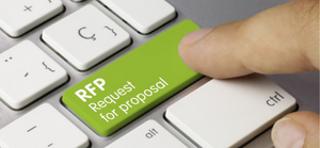
Blogcast #44: A Perspective on RFPs
This is an Impact Pricing Blog published on January 26, 2022, turned into an audio podcast so you can listen on the go. Read Full Article Here: https://impactpricing.com/blog/a-perspective-on-rfps/ If you have any feedback, definitely send it. You can reach us at mark@impactpricing.com. Now, go make an impact. Connect with Mark Stiving: Email: mark@impactpricing.com LinkedIn: https://www.linkedin.com/in/stiving/
9 Mars 20223min
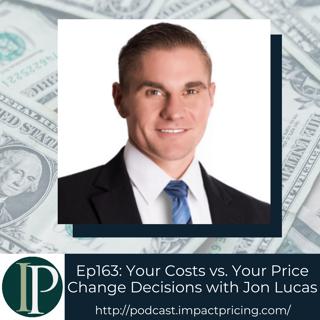
Your Costs vs. Your Price Change Decisions with Jon Lucas
Jon Lucas started as an Accounting Manager before working as the Strategic Pricing & Business Development Manager of Cornerstone Building Brands Inc. Jon loves hiking, and he is loving it even better since he moved out of Ohio. In this episode, Jon engages in a discussion with Mark Stiving about making price changes in relation to the importance of value and volatility of costs in the market nowadays. Why you have to check out today’s podcast: Discover the importance of differentiating your business with the general market when thinking about value and making price changes; Learn how you can manage cost volatility and even add value when deciding on your products’ prices; and Find out why a safe and sound relationship with the sales team is a must when you’re doing pricing “To experienced pricing managers, structure your department, borrow what everybody else in the organization is doing and have an org chart. Put some procedures around it. It kind of sounds like common sense, but I honestly don't see that happening in pricing in a lot of organizations.” – Jon Lucas Topics Covered: 01:21 – How Jon got into pricing; Was it about value or cost plus at first? 03:00 – Jon discusses what Cornerstone does; Thinking about value and differentiating oneself in the market 07:19 – How Jon adds value as he manages cost volatility when making prices 11:29 – Rapid cost fluctuations in the industry as an excuse to change prices frequently 12:35 – Jon talks about Cornerstone’s sales cycle 15:35 – How SAS-based programs help Jon and the company in terms of pricing 16:43 – Does Cornerstone change prices weekly? 19:04 – Jon shares what it’s like working with salespeople 21:03 – Jon’s piece of pricing advice for today’s listeners 22:38 – Having more things to do beyond the role in pricing; the resistance to take on pricing projects Key Takeaways: “When costs move, we know we need to make some kind of pricing move, and it doesn't have to be the same as the cost index. Costs could go up 5%. That doesn't mean we're necessarily going to go up by 5%, because that's where we get the value.” – Jon Lucas “You can kind of use the cost fluctuation as the starting point, then we look at where the value is, and that's where we set our prices.” – Jon Lucas “If you think your competitors are only getting up: if we're making a price decisions every week and they're making price decisions once every six weeks, we've got a much better chance of capturing more margin.” – Jon Lucas “You can put some safeguards around your cost volatility to some degree with the way that you write your contracts. You can kind of do some hedging there. But you're predicting things out in the future, and it's not always going to be perfect. You just got to do the best you can.” – Jon Lucas “You could have the best pricing in the world that you want to charge, but if you can't get it to your customers in a way that works for them, then you're nowhere.” – Jon Lucas People / Resources Mentioned: Cornerstone Building Brands Inc.: https://www.cornerstonebuildingbrands.com/ Zilliant: https://www.zilliant.com/ Connect with Jon Lucas: LinkedIn: https://www.linkedin.com/in/jon-lucas-84557840/ Email: jonwilliamlucas@gmail.com Connect with Mark Stiving: LinkedIn: https://www.linkedin.com/in/stiving/ Email: mark@impactpricing.com
7 Mars 202225min

Blogcast #43: Don’t Confuse Your Buyers
This is an Impact Pricing Blog published on January 19, 2022, turned into an audio podcast so you can listen on the go. Read Full Article Here: https://impactpricing.com/blog/dont-confuse-your-buyers/ If you have any feedback, definitely send it. You can reach us at mark@impactpricing.com. Now, go make an impact. Connect with Mark Stiving: Email: mark@impactpricing.com LinkedIn: https://www.linkedin.com/in/stiving/
4 Mars 20223min
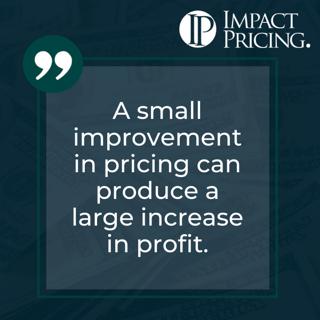
Memecast #48: Small Improvement
I'm going to try to do a little math with you on this podcast, and imagine we have a company that normally makes a hundred million dollars in revenue. They've got costs of $90 million all in. So, they're making $10 million in profit. And that's not unrepresentative, that seems pretty reasonable for a lot of companies. But what happens if we could increase or improve our pricing by 1%? So instead of a hundred million, what if we got 101 million in revenue? Our costs don't really change so instead of 10 million in profit, now we're making 11 million in profit. That 1 million in improved pricing went straight to the bottom line. And in the example I just gave you then, a 1% improvement in pricing can lead to a 10% increase in profitability. This is huge. We should be looking for small places where we can increase pricing because every dollar, when we improve our pricing, goes straight to profitability. We hope you enjoyed this memecast. If you have any questions or feedback, please email me mark@impactpricing.com. Now go make an impact. Connect with Mark Stiving: Email: mark@impactpricing.com LinkedIn: https://www.linkedin.com/in/stiving/
2 Mars 20221min
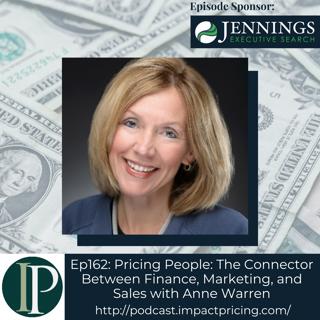
Pricing People: The Connector Between Finance, Marketing, and Sales with Anne Warren
Anne Warren is the Senior Director of Global Pricing at Shure – an appliances, electrical, and electronics manufacturing company that produces best-in-class audio products with high-quality performance, reliability, and value. Anne started out as an accountant and an auditor. She's been leading pricing teams for about 20 years now. In this episode, Anne shares the power behind pricing people working with sales, finance, and marketing departments in order to better market a product in a competitive market. Why you have to check out today’s podcast: Discover why pricing people serve as the connector between the finance, marketing, and sales departments of a company; Understand why rapport with those internally involved in the business is essential in marketing a product; and Know how you can establish an effective rapport with other teams aside from yours through tips from an expert “Establishing the rapport, especially with the sales and leadership team, treating your sales leaders as business partners, and make sure they know – not that you're going to necessarily agree all the time – but that they have a voice and you are going to be collaborative with them.” – Anne Warren Topics Covered: 01:40 – From being an auditor to becoming a pricing person 03:20 – Pricing people being that connector between finance, marketing, and sales 05:41 – Learning about the need to be collaborative across these departments 06:38 – How Anne works with salespeople 08:42 – The context of Anne’s script when talking to customers 10:24 – Mark’s four points with regards to writing a price increase letter 11:09 – Why raising prices shouldn’t be an intimidating initiative 13:33 – How Anna does what needs to be done while working with finance and salespersons 14:59 – Marketing people know the value of their products better than pricing people 16:23 – Seeing the collaboration in different perspectives 18:08 – Having a value statement and being able to share it 19:35 – Product managers being too far removed from value 22:18 – Anne’s piece of pricing advice for today’s listeners Key Takeaways: “It’s important to take yourself outside of your role as a pricing person or as a finance person, and really think and learn, most importantly, about the other person's goals.” – Anne Warren “It's the pricing person's role to be that connector between finance, marketing, and sales.” – Anne Warren “Being transparent. Don't try to hide. Don't try to be mysterious. Be honest with your customers. I think that will definitely go a long way. And the letters that go out are fine, but I think a live discussion between a salesperson and their customer works wonders as well.” – Anne Warren “You want them to feel good about their product. You want to help call out that value proposition maybe in more less technical terms, if it's a technical product, and more about the value prop to the end user customer or B2B customer. What's in it for them and how can we monetize that? Help bridge the gap to get the salespeople confident.” – Anne Warren “Never underestimate the power of a confident salesperson.” – Anne Warren “If you're starting a new job as a pricing professional, I feel strongly you also need a good relationship with finance, but the sales teams in particular, if you have good rapport with them, you're going to make huge inroads and be very successful as a pricing professional.” – Anne Warren “Try to be as natural as you can be, as open and transparent. What is your role? Your role is to be a partner. That is the first message you should deliver to establish that rapport and mean it. Be that partner and establish that early on in the relationship. That's the best thing you can do that will give you firepower for initiatives that you want to perform later on.” – Anne Warren People / Resources Mentioned: Shure Incorporated: http://www.shure.com Ameritech / AT&T: https://www.att.com/ Connect with Anne Warren: LinkedIn: https://www.linkedin.com/in/anne-warren-214ab745/ Email:annewarren720@gmail.com Connect with Mark Stiving: LinkedIn: https://www.linkedin.com/in/stiving/ Email: mark@impactpricing.com
28 Feb 202226min
